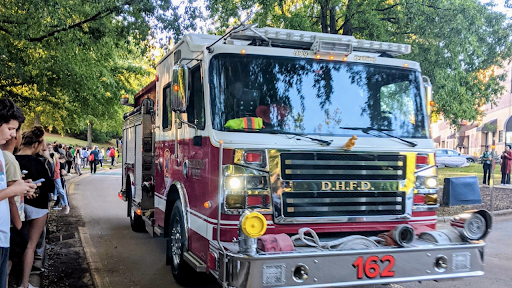The first week of the school year, over five unplanned fire evacuations drew the attention of the student body including Kelsey Abbot, sophomore.
Abbot found the evacuations seemingly random but thought there might be a pattern in the alarms. In order to track the new and distracting events, Abbot began studying the alarm with a journal.
“I just wanted to see if there were any correlations,” said Abbot. “Was it a certain class, was it a certain lunch?”
Abbot tracked the fire drills for the whole first semester, her first recorded evacuation being August 31, and her most recent being January 17. Each entry included the date, class period, and the time of the alarm.
““Whenever it goes off, I take out my phone and screenshot my lock screen so I can look back at it for the time [the alarm] went off so I can record it,” said Abbot via text.
Over the five month semester, Abbot recorded Leesville Road High School having eighteen unplanned fire evacuations. The maximum amount of time in between alarms being fifteen days, and the minimum being fewer than a school day.
Fire Drills and Learning
While these fire evacuations seem like a minor irritation, they have a detrimental impact on Leesville’s ability to learn and teach.
According to LRHS Principal Mr. Solomon, while a scheduled fire drill is short, an unplanned evacuation can last anywhere from ten to twenty minutes depending on the situation.
“[The length of a drill] depends on a number of factors. Where the alarm went off: If it’s in the Murphy building, if they come from the front we have to go all the way through the building to inspect it. We’ve got to make sure there isn’t in fact anything burning at that point. We have to make sure students clear out in a way we need so we have space if something blows up. A lot of things come into play,” he said.
This missed school time adds up over the school year, and at this point could account for anywhere from three to six hours of missed school. The alarms also act as a major interruption, requiring classes to stop their current plans and leave the building for an indefinite period.
Mr. Muffley is a special education teacher at LRHS. While a fire drill can be distracting for a traditional class, they can be significantly more difficult for a student with disabilities.
“Some of our students have difficulty with loud unexpected noises and/or large crowds, so trying to make it outside with the entire school population can be a challenge. Also, some of our students have mobility challenges, so it takes them longer to make it safely outside during an evacuation,” said Muffley via email.
In addition, false fire evacuations harm Leesville financially, making it difficult for the school to buy supplies for classrooms and maintenance.
“This [evacuations] is one of the things that could adversely affect our students. The first two to three [false alarms] we have a pass, but after that you start getting fined. Number three through five is 50 dollars per occurrence, and beyond that they start going up to 100 dollars. We’re in the 100 dollar range now per offense. It goes up to 500 maximum for each occurrence. When individuals do these things, that comes out of our school budget, and it comes out of supplies for you guys that you all need,” said Mr. Solomon.
Leesville’s Response to Evacuations
In order to break the cycle of fire evacuations, Leesville teachers and administrators have created a team and action plan to limit the elicit behavior causing frequent evacuations.
The team has been working effectively, and since November, the number of fire evacuations has dropped precipitously from an average of five to two monthly.
“My team has done an excellent job of finding people when these events have happened bearing down what has transpired,” said Mr. Solomon. “Word has gotten out that we will do the best of our ability figure out who’s doing what and we will address it.”

Hi! My name is Lauren! I’m President of the LRHS book club. Outside of school I’m a curler for Team Taylor and I like to rollerblade.

Leave a Reply